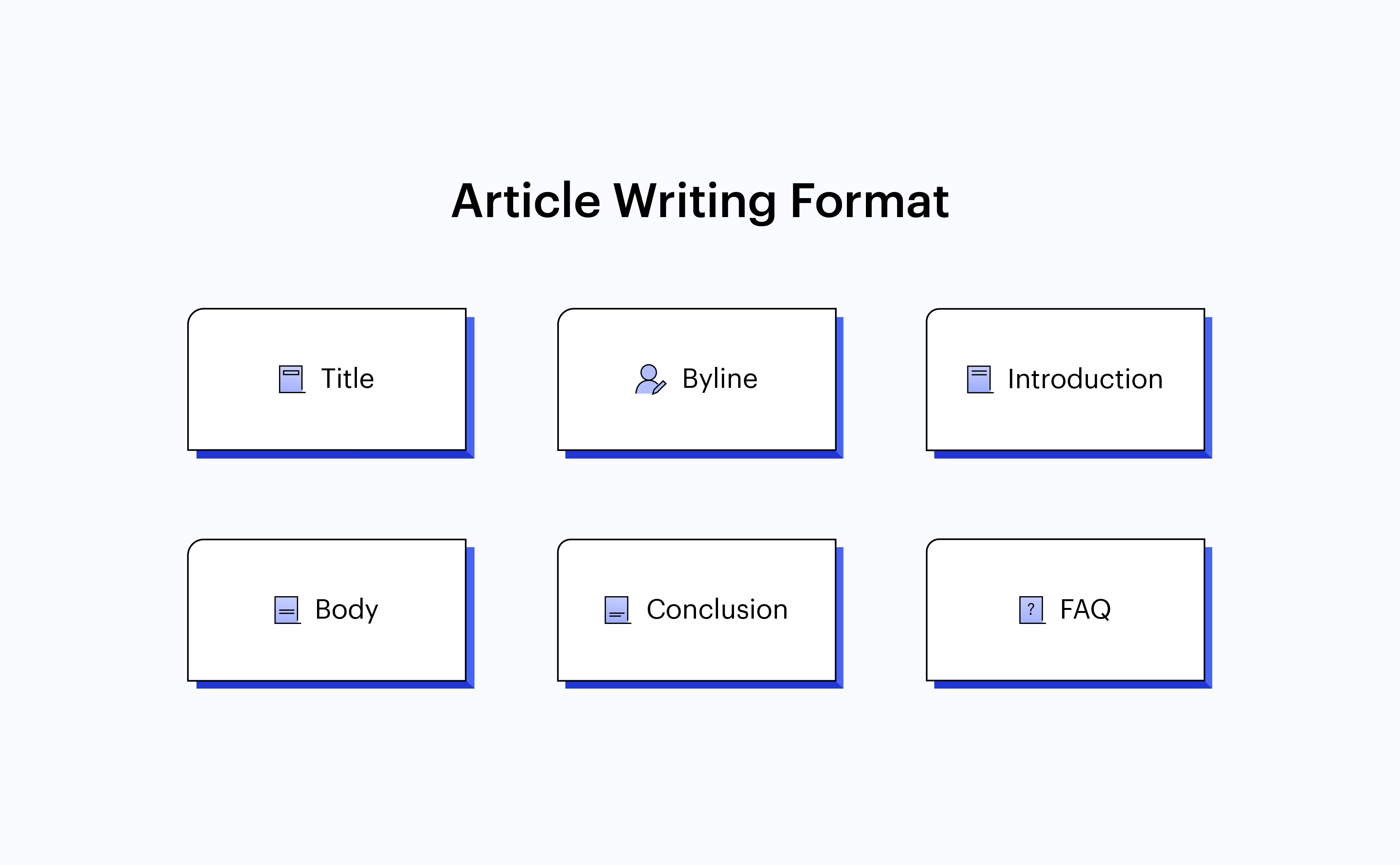Article Writing: How to Write an Outstanding Article (Tips And Example Topics)

Are you on your mission to write an article, and concerned about how to convey your message to the readers satisfactorily? Getting started could be difficult, particularly when you need to get your thoughts together or conclude with an appropriate tone.
If you find it difficult to write an article, following certain simple steps can make the process easier. With the right strategies, you can create perfectly written articles within a short time frame. An established writing strategy helps to make article writing a smooth journey instead of a time-consuming task.
Have you noticed top content writers or bloggers introduce unique content on trending topics? Writers should be careful in this era on how to present their ideas. It needs to be collated in a way that influences a huge audience at the same time. Let’s learn the basics of article writing and the tips to create an effective yet user-friendly article.
What is Article Writing?
Article writing is a type of written communication that focuses on engaging a huge audience in different media outlets. In article writing, the media outlets involve publishing entities like magazines, newspapers, journals, etc.
Articles are written documents that focus on a massive audience to view and conventionally are published in newspapers, journals, books, magazines, etc. Hence, they are considerably shorter than other types of writing like essays or books.
If you consider how to write a great article, the core aspect to remember is that it could be about any topic, from trending events to personal experiences. These are intended to inform, educate, and entertain the readers.
As you become proficient in aligning your thoughts, identifying your audience, and developing an ideal content structure, you will learn how to write articles faster — a skill that improves with time.
Types of Article Writing
Every type of article has its objective, writing style, and purpose. Some are published to consider public opinion, while others are used to inform people about certain topics. According to the purpose, article writing is categorised into four major parts. Let’s discuss the types of article writing with examples to understand them in detail:
1. Expository Article Writing
Expository article writing is the first type that focuses on explaining concepts and ideas precisely. It informs the public about the questions raised through information about the topic. The sole purpose of this article is to define the complex part of the information in a simple format.
Examples: “How to guide” articles, encyclopedias, etc.
2. Descriptive Article Writing
Descriptive article writing elaborates and describes a specific topic, information, or event. This article's writing method demands the writer to explain it thoroughly with every minute detail. The article intends to offer the audience an accurate and reliable event picture.
Examples: Event descriptions, product reviews, etc.
3. Narrative Article Writing
In this type of article writing, you narrate a story of a topic, information, or an event. Here, the style of writing words should be highly engaging and creative. The key emphasis of the narrative article writing is to drive attention to the article and the brand’s website to offer an engaging experience to the readers.
Examples: Biography of famous people, fictional stories, historical events, etc.
4. Persuasive Article Writing
Persuasive article writing is a style that can pursue the views of the user reading or against any information, topic, or event. Creating a hook with a catchy introduction and conclusion is also a part of this writing style. Persuasive writing methods include a convincing representation of an article. It also includes presenting facts and evidence with the topic, offering readers an argumentative opportunity.
Examples: Call To Action (CTA), sales pitch, etc.
How to Write an Article?
1. Choose Your Topics For Article Writing
Your article should discuss a core topic around which everything else revolves. The stronger the topic is, the less likely you are to move on a tangent while the writing process happens. Imagine you are writing an article to promote a new product, say, ‘sleeping bag’. Without a clear focus, the article can be a collection of vague thoughts that can’t offer anything specific to the reader’s understanding. However, when your article talks about ‘how sleeping bags can change the sleeping habits of infants’, it showcases the particular benefits or impacts the product makes for the specific target audience.
You can use Ahrefs Content Explorer to gather ideas and choose a user-specific topic. This content discovery tool helps you search for a topic, and research popular topics, trends, competitors, etc., to build informed content creation strategies.
2. Understand the Audience
It is important to understand what and why before you write an article. Who is the target audience, what age group do they belong to, what respective professional backgrounds, or which industry do they fall under? All these questionable factors pave the way to making a perfectly planned article. These types of questions should be kept in mind before you get started. You should have a detailed understanding of your audience while you plan the article. With the audience and their behavioural patterns in mind, you can gather a broad understanding of how your article should head.
3. Conduct Research
A well-laid topic research lets you dive deeper, explore valuable insights, and offer the audience reliable and accurate information. To build authority on your articles, ensure you select reliable sources — government reports, academic journals, or publications. Get into the minute details of your topic, understand different viewpoints, and decide on how valuable the article should be. Make a fact check, and give credit to the sources you cite in the article to increase reliability and trust. Also, conduct interviews with the subject matter experts for firsthand knowledge. Keyword research helps you find keywords that are ideal for targeting and offers a clear insight into queries that the target audience searches on Google.
4. Create an Outline
An outline is an essential part that helps you focus clearly on writing and make the outcome clearer to the audience. The outline can be as simple as a set of subheadings/subtopics, or a long paragraph summary of the article. Another outlining technique is using mind mapping. Structuring an article works best when you can classify it into similar sections. An article should have a clear introduction and a conclusion. If your introduction focuses on answering a particular query, the conclusion should list the summary points or broad ideas of the answers to that typical question.
5. Write the Draft
If you are writing a long article, delve section by section. Take breaks to refresh your mind and review the content written. Keep in mind what the article is about and stick close to the outline. If you need to make any significant changes while writing, get back to the outline, make the necessary changes there, and get an overview of how the differences reflect in the final article. After being caught up in the writing process, ensure you don’t deviate from the article’s core idea or forget who you write for. Begin every section by tying back to the earlier section. Or begin each section by referring back to the main topic or idea in the article. Mention sources while including statistics, facts, and figures from an external source. Add citations if you are writing an academic article.
6. Get the visual elements ready
An article might not necessarily have visual elements. However, the visual elements, such as images, photographs, embedded videos, illustrations, and infographics, can improve your article. In the case of a long article, the visual elements can break the long sections of text, making it highly readable. Also, they can focus on the points you make in the article. The decision on whether to accommodate visual elements or not in the article and the number of elements to include in the article depends on your capability to create or source the visuals.
7. Revise and Edit
The work doesn’t stop after writing the conclusion paragraph. Once you finish your first draft, it is time to give your article the space for a detailed review. Check the article for grammatical errors. You can use tools like Grammarly or Quillbot to make an easy quality check. Also, ensure the article is well-structured and every section seamlessly flows into the next. Put yourself in the audience’s shoes while reviewing the article. Also, think back to your article's core topic and idea, and check whether you have stayed on track with the content. You may also get the article reviewed by another person, probably the team member or the proofreading expert for genuine feedback.
8. Optimise for SEO & Publish
SEO is an inevitable factor for any article to be published online. Before the article goes live, the content specialists should help optimise the article. However, if you wish to work to make the article SEO-friendly, gather a list of keywords necessary to support your core ideas or topic. You can also use paid keyword research tools to optimise the article. Since SEO is a vast segment, it is a major part you must focus on after you gain a certain degree of proficiency in the different areas of article writing.
Article Writing Format

An article should have a heading or title and a description that states what it is all about. The body of the article can be split into 3-5 paragraphs based on the content volume and aligns with the topic you discuss. You can include subheadings and incorporate bulleted points wherever possible.
Make sure that the introduction leaves people excited about the whole article and that the conclusion keeps them satisfied. The article should be properly organised to drive the readers’ attention. Here is an ideal outline for an article writing format:
1. Title
A title grabs the attention in the beginning and persuades the reader to go through the article further. With a compelling title, you can engage the audience and convey the significance of the article to the reader.
For instance, “10 Untold Facts About Artificial Intelligence that Leave You Shocked” grabs attention quickly, which forces the readers to go through the blog and explore these hidden facts.
2. Byline
The next part is a byline, which appears beneath the title and beholds the author’s name. It helps the author to earn credit for the content he/she has created.
3. Introduction
The introduction is as important as it offers a clear preview of the content, which makes the audience choose whether to read the article further. This is a gateway to the entire article.
4. Body
The part of the content that holds the entire soul of an article is its body. Here, the writer explains his/her views. It includes paragraphs, and sections that explain the matter. It usually includes the following elements:
Sections and headings: Dividing the main content into headings and sections improves the structure and readability of the article. It classifies the information, which makes the article more accessible and engaging.
Heading 1: Heading 1 is also called the H1 tag, it gets reserved specifically for the article’s main title. This is the most important heading, which should provide a detailed overview of the content and include the target keyword. It is usually at the top in terms of hierarchy. A page usually contains only one <H1> tag.
Heading 2: Also called the H2 tag, it classifies your content into key topics or sections. These give the audience an idea of all the major points you will incorporate in the article. Use them as the outline’s skeleton and to convey the search intent. H2 tags are seen as the next level down in the hierarchy.
Heading 3: Also called the H3 tag, these subheadings divide main sections into smaller subheadings. They offer specific information to support the H2 heading and make a logical flow.
You may also subdivide content with H4, H5, and H6 tags. However, you don’t need to emphasise these tags.
Tip💡: Make sure that the headline is crisp and precise with 5-6 words because the long ones can cause disinterest in the first impression.
Conclusion: The conclusion holds everything together and reminds readers about the key ideas, leaving a deep impression while making the article’s true intent stick in their minds.
Tip💡: Incorporate a question in the concluding section to improve reader engagement, or give a snapshot of the entire article in precise capsule points for a smooth wrap-up.
Frequently Asked Questions (FAQ): FAQs offer detailed answers to the common questions of a reader. It improves the reader’s satisfaction, which makes the article highly helpful and informative.
Article Writing Examples
A great article should be concise, clear, and engaging, and provide valuable information while maintaining logical structure. Here are some major examples of the best article samples you can refer to and understand how a well-written article should be.
Article Writing Tips
To be equipped to write an article that makes sense, there are some things you should keep in mind.
- Plan well before you pen
- Write articles of good length (between 1500- 2500 would be optimal)
- Mention the author
- The title should be clear, lengthy, and catchy
- The heading should be crisp, clear, and informative
- Target the audience
- Make sure that the introduction and conclusion are attractive and attention-grabbing
- One can suggest, advise, and offer solutions to concern in a paragraph in subsequent paragraphs
- The writing style and language should be aligned with the concerns of the readers
- Incorporate proper punctuations
- Make use of any person, tense, voice, abbreviations, and self-built words during article writing
- Highlight important information
- Incorporate bulleted points, subheadings, and small paragraphs
Summing Up
The biggest key to article writing is to be aware of what you are writing about, and whom you’re writing it for. You need to have an appropriate outline before you start writing the article. Ensure you review the work in depth while writing and stay on track while maintaining a high quality.
Keeping the steps mentioned, the format, and the tips in mind, you can write highly engaging articles. A wordsmith is not born overnight, however following the steps we’ve discussed could be the best way to make a well-structured, interesting, and informative article that glues the eyes of the readers.
Need Compelling Content for Your Business?
Let Our Experts HelpLoading...
FAQ
Discover Digital Transformation
Please feel free to share your thoughts and we can discuss it over a cup of tea.









